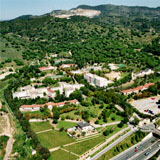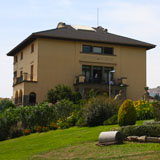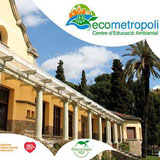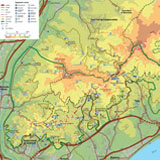Torribera premises

The lands of Torribera are owned by Diputació de Barcelona local administration. It is a 84-acre area located north of the city of Santa Coloma de Gramenet and on the mountain side of the Serralada de Marina Park. It is next to Torre Pallaresa, and in a straight line it joins Universitat Autònoma de Barcelona's Biomedical Campus and the university hospital Germans Trias i Pujol, also going past the historical monastery of Sant Jeroni de la Murtra in Badalona. In 1916, these lands were acquired by the Mancomunitat de Catalunya (chaired by Enric Prat de la Riba) so as to locate a complex of buildings intended to become a treatment center for mental illnesses. It is found in the Carcerenya valley (Gramenet) and is called Masia de Torribera, documented since back the 18th century. The social and architectural project from 1917, carried out by the architects Rafael Masó and Josep Maria Pericàs, is in keeping with the Catalan cultural movement of the 'noucentisme'. Its orientation, facing south, with an exceptional sunlight illumination and sheltered from winds by the Serralada de Marina's mountain range, delivers an unmatched quality of life. Regarding the 'Torribera' name, the first record of it appears in 1238, and the central part of the building dates back to the 15th century. Later on it was registered as Torre Ribera after its owner, Joan Ribera (1566). Some time later, from 1617, the monastery of Sant Jeroni de la Murtra took its ownership and remained like this until the confiscation of church properties in 1822, when it shifted into private hands.
Nowadays, in Diputació de Barcelona's Torribera premises we can find the following entities and educational and welfare institutions:
-
Welfare Centers Dr. Emili Mora i López
In 1926 Diputació de Barcelona authorized the construction works for these buildings, which started its activity in October 1930 with ninety chronic patients from Sant Boi's mental hospital. The extension works were followed by a plan for a new series of pavilions until 1962. Ten years later La Masia building was closed for welfare use, and from 1983 to 1993 Nursing and Physiotherapy Gimbernat School held some studies there. In 1992 Dr. Emili Mira i Lpez School added another course offering and two years later it started socio-health care activities in the framework of the Catalan public health service (Servei Català de la Salut). On June 16, 2003 these health care entities in Torribera premises changed its name to Welfare Centers Dr. Emili Mira i López. Finally, on December 22, 2009 Generalitat de Catalunya's Governing Council approved the transfer of the welfare centers from Diputació de Barcelona to the Generalitat itself, and an agreement was settled between Servei Català de la Salut, Diputació de Barcelona and the MAR Health Park.
The mental health clinic opened in 1930 was called Centre Assistencial Torribera (1997) and, subsequently, Centres Assistencials Dr. Emili Mira i López (2003). Emili Mira (1896-1964) was the doctor in charge of the Republican Army's psychiatric services during the Spanish Civil War (1938).
To know more:
R. Sagués, R. Pérez Simó, J. M. Claperols i S. Martínez Palou, Setanta-cinc anys d’assistència psiquiàtrica: de clínica mental a Centres Assistencials Dr. Emili Mira i López. Diputació de Barcelona: 2005.
-

University of Barcelona in Torribera premises
Initial stage (1996-2007)
University of Barcelona's presence in Torribera dates back to 1996, with the arrival of the Centre d’Ensenyament Superior de Nutrició i Dietètica (CESNID), which offered the bachelor's degree course in Human Nutrition and Dietetics in La Masia building. The convention with Bosch i Gimpera Foundation had been signed on September 29, 1995, with a subsequent addendum on May 31, 2001. La Masia building was restored in 2000 by Diputació de Barcelona's architect Sílvia Martínez Palou.
The three promoter institutions of this project (Diputació de Barcelona, Santa Coloma de Gramenet's City Council and University of Barcelona) created, on February 18, 2007 the Office for the Promotion of the Food and Nutrition Torribera Campus (OPCAT), with the object of coordinating its development.
Building works stage (2008-2010)
On April 25, 2007 a convention was established between Diputació de Barcelona and the UB, updating former agreements and widening the action fields to three new pavilions for a total 7.322 m² and a 1.400 m² greenhouse installation with the right of use for 75 years. Besides, it was specified the use given to La Masia building, which has a total surface of 1.400 m², as well as the commitment to draft an special plan for the Torribera site in which it would figure the possibility of raising new buildings to a surface up to 40.000 m².
By the end of May 2010 it was finished the remodeling of the three pavilions (Verdaguer -2.200 m²-,
-
-2.178 m²- and Marina -3.468 m²-), thus added to the Food and Nutrition Torribera Campus, which had already at its disposal La Masia building. Their inauguration took place on the occasion of the 2010-2011 new EHEA bachelor's degree courses presentation.
Beginning of the new bachelor's degree courses attached to the Faculty of Pharmacy (2010-2012)
Coinciding with the 2010-2011 academic course, about 300 new students from the two bachelor's degree courses attached to the Faculty of Pharmacy (Human Nutrition and Dietetics and Food Science and Technology) started their studies in Torribera. When the academic course 2012-2013 began —that was the third year these degrees were offered—, there were already 500 students who, along with the teaching staff located in the teaching and student services building (Verdaguer), all administrative and service staff and the research groups housed in the new laboratories of the research building (Gaudí), made up the new university community of the Food and Nutrition Torribera Campus.
-
The National Distance Education University (UNED)
Since its creation in 1972 as a distance education university, UNED has expanded its presence all over the Spanish geography by means of associated centers. In Catalonia there are four of these centers, and since July 2, 2012 UNED has a central headquarters building in the city of Barcelona (in Nou Barris district). The associated UNED center in Terrassa has got a series of extensions among which the most remarkable is the one in Santa Coloma de Gramenet, located in La Torre building in our Torribera premises. The studies attached to this extension are mainly the bachelor's degree courses in Social Education, Psychology, Social Work, Social and Cultural Anthropology, Law and Modern Languages.
-
Ecometròpoli (Santa Coloma de Gramenet's Environmental Education Center)
Ecometròpoli is a space intended to share knowledge and foster all those values linked to nature conservation and urban sustainability, as well as to disseminate the balance of Serralada de Marina Natural Park's ecosystem. It is promoted by Santa Coloma de Gramenet's City Council and housed in Montserrat pavilion, where has about 1.000 m² at its disposal.
-
Serralada de Marina Natural Park
Serralada de Marina Park, located between Barcelonès and Maresme counties, was created in 1997 and five years later, in 2002, it saw its first Special plan approved. The management of this space is assigned to a consortium formed by several neighbour town's City Councils, Diputació de Barcelona and, since 2007, also by Generalitat de Catalunya. It has an area of 5154 acres which connect, in a South-North direction, the Catalan Coastal Range and Collserola Natural Park. In this area there are three of the most densely populated cities in Catalonia: Santa Coloma de Gramenet, Badalona and Sant Adrià de Besòs, along with Tiana and Montgat to the north.
Torribera Campus
Contact Details
- Food and Nutrition Torribera Campus
Prat de la Riba, 171 - 08921 Santa Coloma de Gramenet
Tel.: 934 031 980 - Fax: 934 031 952
- campusalimentacio
torribera@ub.edu - How to find us







